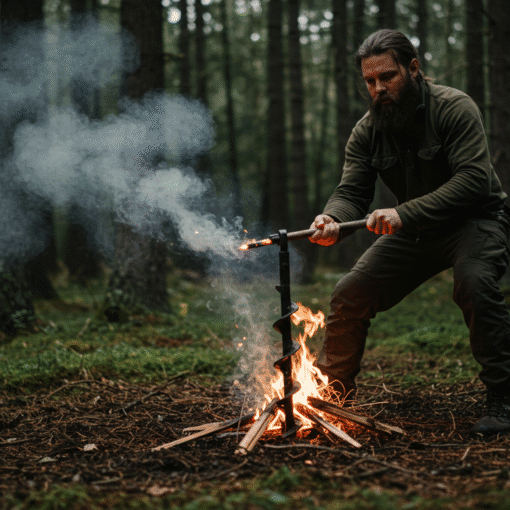Top Takeaways and Key Concepts
- Stay calm first to assess your surroundings and make smart survival decisions.
- Locate safe water fast by finding streams, collecting rain, or using filters.
- Carry a basic first aid kit and know how to treat minor injuries and wounds.
- Use nature to navigate by following rivers, trails, or the sun when lost.
- Build simple shelter using branches, leaves, and high, dry ground to stay safe.
Summary of This Article
This article teaches basic survival skills anyone can use when lost or facing trouble outdoors. It emphasizes staying calm to think clearly, assessing your surroundings for danger, and finding clean water quickly to stay hydrated. It also explains the importance of carrying a simple first aid kit to handle injuries and using natural navigation methods when GPS is unavailable. Finally, it highlights building quick shelters to stay warm and dry, reminding readers that survival is less about luck and more about preparation, awareness, and a positive mindset.
Short Video Version of this Article
Picture yourself outside, with big trees and birds singing all around you. You feel like a brave explorer ready for anything. Then, oops! You trip over a root that was lurking in the grass and fall into a puddle of mud. Or maybe you make a wrong turn and end up lost in the woods. Oh no!
Don’t worry! We all go through it. You can manage it like a pro if you know some fundamental survival skills. That puddle of mud? Just think of it as a fun and chaotic spa day for yourself.
Please Note: This post may contain affiliate links. If you click one of them, we may receive a commission at no extra cost to you. As an Amazon Associate, I earn from qualifying purchases.

It can make a big difference to know what to do. If you get lost, for example, stop and take a deep breath. Listen for sounds like running water or voices, or look for something you know. Those might help you find your way back.
If you’re really stuck, just remember to be calm. It’s easy to freak out, yet staying calm helps you think clearly.
It’s also a good idea to include some food in your bag. When things get tough, eating a little bit might provide you energy and lift your spirits.
So the next time you’re out in nature, remember: even if anything bad happens, you have the skills to fix it and get home!
Assessing Your Situation – The Calm Before the Chaos

First things first—take a deep breath. Seriously, I mean it. In moments of panic, it’s easy to forget that inhaling is essential for staying alive.
Once you’ve calmed down enough to remember how to breathe properly, take stock of your situation. Ask yourself: What just happened? Am I injured? Is there anyone else around who might be laughing at my misfortune?
Assessing your surroundings is super important. Just take a moment to look around. Are there steep cliffs nearby? Or maybe some wild animals that could be more interested in you as a snack? Yikes!
If you find yourself alone and you’re not hurt, that’s great news. You’re already ahead of the game! Take a deep breath. Seriously, it helps. Panicking won’t do any good. It might make you think climbing a tree is a smart idea because, well, it seems fun at the moment. But let’s be real—trees can be tricky!
Instead, try to stay calm and think clearly. Look for things that can help you. Is there a path or trail nearby? Maybe even some footprints? That could lead you back to safety.
If you see water, that’s awesome too! Water means life and can help keep your spirits up. And if you’ve got snacks with you—score! A little munching can boost your energy.
So remember, take a moment to assess what’s around you. Stay calm and don’t rush into decisions. You’ve got this!
Finding Water – The Lifeblood of Survival

Let’s chat about water—the stuff we really need but often forget until we’re super thirsty. It’s wild, right? Humans can go weeks without food but only a few days without water. So while you’re out there trying to build a fancy shelter with twigs and leaves (we’ll get into that later), don’t forget to drink up!
If you find yourself lost in the wild and need water fast, look for streams or rivers. Just make sure they don’t look like something from a scary movie! Clear running water is your best bet. Murky puddles filled with weird bugs? Yeah, probably skip those unless you’re really desperate.
If you can’t find any fresh water nearby, think about collecting rainwater using big leaves or containers if you have them. Just picture it—sipping on “nature’s finest” instead of some sketchy creek juice!
Portable water filters are great too. They make even questionable water safer to drink. You know, it’s like having a little magic wand for your hydration needs!
Stay smart and keep an eye out for good drinking options. Water is key to keeping your adventure going strong!
First Aid Basics – Band-Aids Aren’t Just for Kids

Now let’s address injuries—because let’s face it; accidents happen even when we’re trying our hardest not to trip over our own feet! It’s wise to carry some basic first aid supplies whenever venturing outdoors.
A small kit containing adhesive bandages, antiseptic wipes, gauze pads, and pain relievers could make all the difference between feeling miserable or merely uncomfortable.
Knowing some basic first aid can really help if someone gets harmed or if you’ve had too much fun battling with branches. It could save lives or at least spare you from having to tell really humiliating stories later.
For instance, did you know that just putting pressure on a wound might help stop the bleeding? It’s so easy! Who knew that could stop you from becoming a human fountain? Isn’t that crazy?
And those annoying insect bites? Don’t disregard them! At first, they might not seem like a big deal, but scratching can create infections that are much worse than missing your favorite show because the Wi-Fi is down. Ouch!
Before you leave, make sure to bring some bug spray. It’s like a shield against those annoying bugs that want to ruin your fun. Taking care of your skin means more fun in nature and less itching.
Just keep in mind that being ready makes things easier! You can do this!
Navigating Your Way Home – No GPS Required

Alrighty then! Now that we’ve covered assessing situations and tending wounds like pros let’s tackle navigation—because wandering aimlessly is fun until it isn’t anymore (like when night falls faster than expected).
When you’re lost in a place you don’t know, it can feel super scary. Without fancy gadgets to guide you home (thanks, technology!), natural landmarks can be your best friends.
For example, rivers are great! If you follow them downstream, they usually lead to places where people live. Just watch out if the river suddenly drops off a cliff. Yikes! That would need a whole different set of survival skills!
Another cool trick is using the sun as your compass buddy. If it’s morning and shining on one side of your body while making shadows on the other side, that’s east and west right there! It’s like nature’s way of helping you out.
But if clouds come and cover everything? Well then… good luck figuring that one out! Just take a deep breath. Sometimes, just walking for a bit helps clear your mind.
Trust yourself. You’ll find your way again!
Building Shelter – Not Just for Boy Scouts Anymore

So here we are—you’ve got fire skills mastered; you’ve found clean drinking water; treated any boo-boos along the way… now what? Time for shelter building! Because sleeping under open skies sounds romantic until raindrops start pelting down like tiny hammers determinedly knocking sense into our heads.
Building a simple lean-to can be super easy. Just grab some branches and lean them against bigger trees. No fancy degrees needed for this! It’s like making a fort, but for staying safe and dry.
Location matters a lot too. You don’t want to pick a spot where water collects after it rains. Unless you’re planning on swimming, that’s not the best idea! Staying dry is key.
Insulation is another big deal. Gather leaves or pine needles to make a cozy bed. They’ll help keep you warm and snug instead of letting cold air sneak in under your clothes. Who wants to shiver when they could be comfy?
Just think of it as nature’s way of helping you out! You got this!
Conclusion – Embrace Your Inner Survivor
I sincerely hope you feel strong right now. Not terrified or anxious about every little thing that could happen while you’re outside! Yes, emergencies can happen when you least expect them. It seems like they always do that, doesn’t it?
Being ready is your best buddy. It makes a great difference to know what to do ahead of time. It’s like putting away an umbrella before it rains. When you panic, you don’t want to try to sort things out. That’s just too much tension.
If you learn these survival skills before you go out, you’ll be ready for anything nature throws at you. You might think of it as a pleasant experience where you can be both smart and safe. It shouldn’t be scary to explore. You can do this! Take a deep breath and enjoy the voyage through nature’s playgrounds!
Frequently Asked Questions
1. What is the first thing I should do if I get lost outdoors?
The most important first step is to stay calm and assess your situation. Panic leads to poor decisions, so take a deep breath, check for injuries, and observe your surroundings before taking action.
2. How do I find safe drinking water in the wilderness?
Look for clean, flowing water like streams or rivers, and avoid stagnant puddles. If possible, use a portable water filter or collect rainwater with containers or large leaves to stay hydrated safely.
3. Why is carrying a first aid kit important?
A small first aid kit allows you to treat cuts, scrapes, bites, and minor injuries before they become serious. Knowing basic first aid, like how to stop bleeding or clean wounds, can prevent infection and save lives.
4. What natural methods can I use to navigate without a GPS?
Follow rivers downstream, as they often lead to populated areas, or use the sun to find direction. In the morning the sun rises in the east and sets in the west, helping you stay oriented when lost.
5. How do I build a simple survival shelter?
A lean-to shelter is easy to build using branches leaned against a large log or tree. Add leaves or pine needles for insulation and choose a dry location away from low ground or rain runoff.
6. Why is staying calm so important in survival situations?
Staying calm helps you think clearly and make smart choices instead of acting on fear. It allows you to conserve energy, avoid dangerous mistakes, and focus on finding solutions.
7. What basic supplies should I always bring on outdoor trips?
Essential survival items include water, snacks, a first aid kit, a knife, matches or a lighter, and bug spray. These small items can make a big difference in comfort, safety, and survival.
Suggested Resources:
Wilderness First Aid Guide
https://www.wildernessfirstaid.com
How To Build a Shelter in The Wild
https://www.survivalshelterguide.com
Water Sourcing Techniques
https://www.outdoorlife.com/how-to-find-water-in-the-wild/
Basic First Aid Tips
https://www.redcross.org/get-help/how-to-prepare-for-emergencies.html

Kevin Collier is a seasoned outdoor enthusiast and writer for Trekbug.com, specializing in outdoor adventures, survival strategies, and prepping insights. With a deep love for nature and a commitment to self-sufficiency, Kevin empowers readers to embrace the wilderness confidently. He shares valuable tips, practical techniques, and inspiring stories, helping both novice and experienced adventurers develop essential skills for surviving and thriving in the great outdoors.





